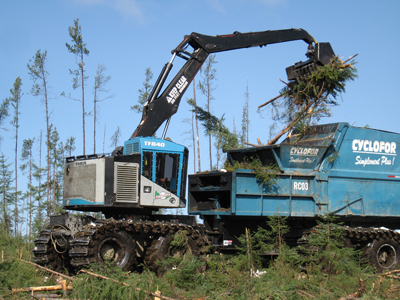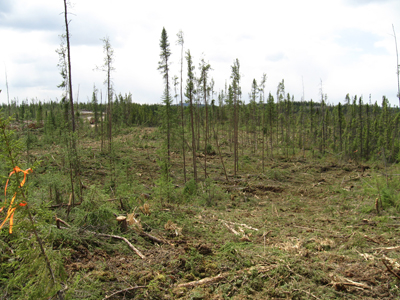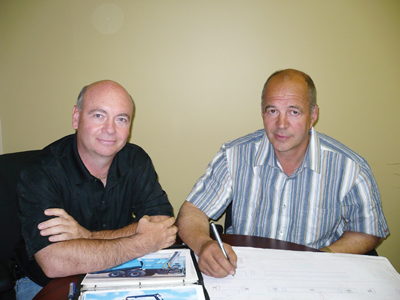
Taking out the Trash
May 20, 2009
By Gilles Boucher & Scott Jamieson
For years farmers have recuperated just about everything from their harvest sites, while nearby loggers leave almost as much behind as they take out in terms of pure volume
For years farmers have recuperated just about everything from their harvest sites, while nearby loggers leave almost as much behind as they take out in terms of pure volume. Yet now with energy prices soaring, what was once an eyesore and a cost item left after logging is now starting to take on a golden hue. To cash in on this once-waste product, Cyclofor Inc. of La Sarre, QC, has developed an entire slash collection and processing system – The RC-03 forwarder-compactor to recover slash for the harvest site and move it to a central sorting and treatment centre that will direct the slash to its highest end use, from whitewood chips to hog fuel, and everything in between.
 |
| The RC-03 forwarder-compactor is based on a Timberpro heavy-duty forwarder, but includes a purpose-built grapple with saw and knife, an infeed funnel and compactor rod (middle section), and a removable container that transports 15 tonnes of slash. |
The RC-03 is a slash “forwarder-compactor” created by Daniel Tardif. The current model was developed from two earlier prototypes that the longtime heavy-equipment mechanic tested. His 30-year career includes work in sawmills and other industries as a mechanic and continual improvement entrepreneur. Like many others today, he insists that we need to start using the whole of the forest resource, adding that we’re talking an impressive volume if, and this is the big if, we can find a mechanically sound and economical way to collect and transport the fibre.
The RC-03 is thus the fulcrum for Cyclofor’s whole business model. It is being field-tested and proven now both in the Abitibi-Temiscamingue region of northwestern Quebec, as well as in northern Ontario, near Opasatika. Both these forest regions have immense volumes of available harvest slash.
The machine’s base is a rugged Timberpro TF840 forwarder, with 22-tonnes of capacity on 24-tonne tandems. It is driven by a 300-hp Cummins, while the chassis has been stretched to 35 feet in length and 12 feet wide for the application. The RC-03 rolls on 42-inch tracks mounted on 10.5-foot tandems. As a result, despite its size, the RC-03’s ground pressure is similar to other 14- or 16-tonne forwarders.
Everything above this solid base, or as Tardif says, “everything above the wheels”, was designed and built by Tardif and Cyclofor. This includes the skookum grapple at the end of the forwarder boom, which has a bar saw on one end, as well as a knife on the other for cutting the smaller slash that has the nasty habit of derailing the saw chain. And like all Timberpro cabs and loaders, they pivot 360 degrees, allowing for efficient slash pickup.
 |
|
| A cut-to-length (CTL) harvest site after Cyclofor has been through. The trail is that used by harvester and forwarder to extract sawlogs and pulp wood according to Quebec’s 25% limit on machine travel. This allows high regen on both sides, but traditionally creates a heavy concentration of slash in the trails. Now spot planters planting the trails only have easy access to planting sites. |
Behind this cab is a unique slash collection and compaction system, as air is the enemy of all efficient slash handling systems. This patented gear allows Cyclofor to “compact all the harvest residue in interchangeable containers, and then transport these in an efficient and safe manner, while conserving the intrinsic value of the material,” explains Alain Brodeur, forestry director and Tardif’s business partner.
And based on early results, it works. Trials in varied conditions show that the RC-03 requires one operator to collect and compact slash at a rate of 15 tonnes or more per hour, and that it can work non-stop in 24/7 operations as needed, just like any other forest operation in this part of the world. Moreover, replacing a full container for an empty one takes just minutes, all done without the operator ever having to leave the safety of his cab. The machine also benefits from a full automation and control package, from GPS (you’ll know where you’ve collected slash already, day or night) to a full on-board computer. This is no taped-together concept, but a system designed for the long haul.
Once filled with 15 tonnes of slash, the container is dropped off at a transfer point where an empty container awaits. The full container is picked up by a truck that carries two per trip to the sorting and processing centre. Here it picks up two empty containers, and continues the cycle. Logistics are obviously a big part of the operation.
Sort for Value
The second stage of the Cyclofor operation takes place at the sorting and processing station. Depending on markets, such stations could employ up to 150 people for each and every region where it is possible to collect one million cubic metres of slash per year. The company has already identified several such areas. “The trick is to run the operation with a minimal impact on the environment, recuperate the maximum volume and value of material, and in the end turn a profit from it all,” says Brodeur. “The larger manufacturers have systems in place, but the majority we saw required too many machines and operators for us to see a profit in the end. It was up to us to find a way, under local conditions, to do the work with a minimum of machinery, in a simple, efficient operation, and to adopt some familiar pieces to do different work. The RC-03 solved this with one machine and one operator.”
Based on 15 tonnes/hour, 20 hours/day, and 250 operating days, one can imagine some 13 to 15 RC-03s plying the woods in one region, for a scale of biomass operation unheard of in most of North America. For now, the company has one machine working, back in the woods since mid-March, according to Patrick Paiement, a keen young forest engineer who heads up woods operations for Cyclofor. When Canadian Biomass spoke to Paiement in mid-June, the machine was working basically 24 hours/day, five days per week, with two production shifts, and a third that takes care of maintenance in addition to compacting biomass. They had worked behind both full tree operations recovering slash at roadside, and behind CTL operations. “The only thing we ask them to do is leave us space for the spare containers,” Paiement says.
Once at the sorting station, material will be divided into four principal sorts. The first step will be to create debarked whitewood (hardwood or softwood) that will allow Cyclofor to offer products depending on demand – chips, shavings, sawdust/particles, or bark and other material for energy biomass. Waste material making one product, or slash too small for even specialized debarking, will serve as a product in other categories. Potential clients include panel mills, pulp mills, agriculture, pellet and energy plants.
 |
|
| Alain Brodeur, Cyclofor forestry manager, and Daniel Tardif, the RC-03 inventor have big plans for the region’s slash.
|
As for the environmental balance, it looks pretty good. The slash piles now decomposing on forest sites not only reduce the area available for reforestation, but will in its turn create greenhouse gases over time. The component of Cyclofor’s mix going to bioenergy will create the same gases, but will do so while replacing fossil fuels. The rest of the material will be used in products such as panels or papers, storing GHGs for anywhere from months to decades. Finally, larger volumes growing on the cleaner sites means more GHG storage per hectare.
The effect of the RC-03 moving over the site will be negligible, as it will travel on existing skidder trails. In this region it will also encourage reforestation by reducing the volume of processor slash on site. “What we’re offering is an increase in the area traditionally available for re-planting compared to traditional site preparation methods,” explains Brodeur. “Moreover, all the following silvicultural work and inventory work will be simplified by removing the excess slash. This treatment is being studied by the MNR in the hopes of making it a recognized site prep treatment.”
Of course this would only further enhance the economic viability of the overall Cyclofor process. Cyclofor has already worked with a host of consultants in forestry, metallurgy, finance and accounting, human resources, computer systems, technical and architectural design to nail down the final design. Also key, the provincial government has authorized the recovery of slash in certain zones of this immense forested region. A co-operation agreement has already been developed with a local forest company, as well as with regional private woodlot co-ops to diversify the fibre supply.
For the near future, the entire concept is being studied by a research collective to optimize the collection and transport process. The group includes FERIC, The CAF Group, and Kekeko Forestry, and the results of their study will be released soon.
The final piece of the puzzle is up to the folks at Cyclofor. They are developing a debarking system for the sorting station that will let them extract maximum value from material larger than 4 centimetres. They’ve designed a specialized drum-style system that will do a better job, with less damage, than current systems. In the end, it will be the ability of Cyclofor to extract a maximum volume of whitewood, in all its forms, that will make the sorting station a paying proposition. Otherwise, you may as well chip it all in the bush.
To test this new system, the company has built a prototype sorting/processing centre in La Sarre on the site of an old Tembec sawmill (with infrastructure already in place). This started up before the end of June 2008, and will serve above all to test the crew’s ability to efficiently sort white wood out of the slash from pieces down to 4 centimetres. Slash will be brought to the line by a Bobcat, where it will travel up 45-degree inclined and counter-rotating screw conveyors to be dropped into a series of three drum-style debarkers. These are designed and built by Cyclofor, and create an increasingly fine screen for separating the white wood from the bark, dirt, small stones and sand. The design uses rotatable feller buncher teeth arranged close together, with just a small percentage of the tooth sitting above a set of guards. The really small material (mostly mineral) will drop all the way through and be composted, while the rest either drops out as it becomes very fine (bark or very small wood pieces), or continues on to the next drum.
In the end, white wood leaves the third, finest drum, and continues on to a vibrating conveyor and chipper, followed by vibrating screens to sort out the various white wood products, including pulp chips and material for panel producers. These will be loaded straight into waiting vans to avoid contamination.
While you can imagine a higher percentage of white wood being lost by volume than say a traditional log debarking and chipping operation, it’s important to remember that the alternative was once just to burn it all or leave it in the bush. We’ll continue to follow progress on this innovative company’s development.
Translation and additional reporting and updates by Scott Jamieson.
Print this page